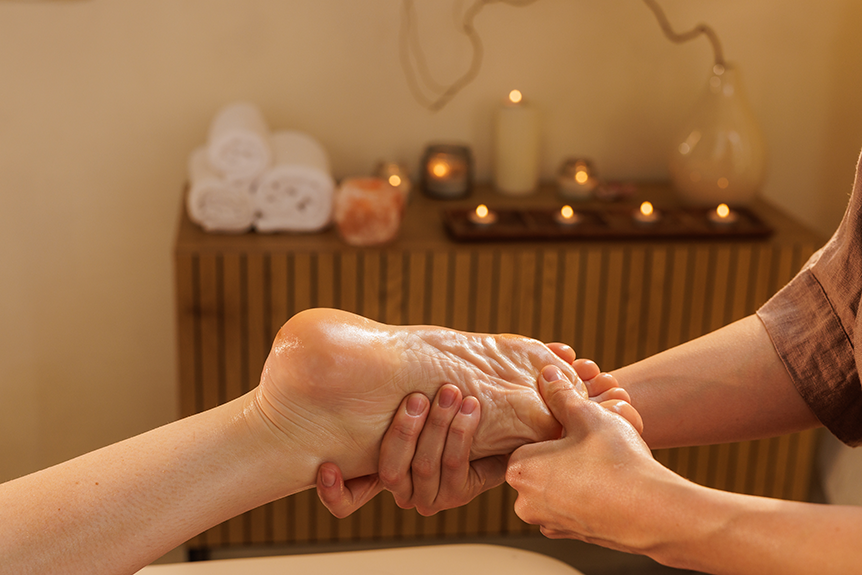It is generally considered safe when performed by qualified practitioners; however, adverse effects such as transient fatigue, headaches, or minor tenderness can occur. Significant harm is rare but possible if contraindications like vascular disorders, recent surgeries, or pregnancy complications are present. Proper practitioner hygiene, expertise, and client communication are essential to minimizing risks. Selecting a certified reflexologist and disclosing medical history enhances safety. Further insights highlight specific situations and precautions associated with zone therapy practice.
Understanding It: What Happens During a Session

A typical massage session at Spa & Massage involves the application of targeted pressure to specific points on the feet, hands, or ears, which correspond to various organs and systems within the body according to its theory.
Highly trained therapists employ precise digital compression techniques, utilizing their fingers and thumbs to stimulate these reflex zones. The procedure is conducted in a serene environment, fostering a sense of safety and personalized care.
Each session begins with a brief health assessment, ensuring that pressure is attuned to the client’s comfort and health status.
At Spa & Massage it is designed to promote relaxation and support overall well-being, integrating evidence-informed practices while respecting individual boundaries, consequently facilitating a holistic, nurturing experience tailored to the client’s unique needs.
Incorporating the healing power of zone therapy, these sessions aim to enhance both physical and emotional wellness by focusing on interconnected areas of the body.
Common Side Effects of Reflexology
Following the thorough explanation of the zone therapy process at Spa & Massage, it is important to acknowledge that, while generally well-tolerated, it may be associated with certain mild side effects.
Clinically, some individuals report transient symptoms such as slight fatigue, mild headache, dizziness, or increased sensitivity in the treated area following a session.
Occasionally, temporary tenderness or minor bruising can occur, particularly if firm pressure is applied during treatment.
Gastrointestinal responses—including increased urination or bowel movements—are also sometimes observed, as it may stimulate systemic circulation and lymphatic activity.
In our clinics, therapists closely monitor clients’ comfort and adjust techniques as needed to minimize discomfort.
These effects are typically short-lived and resolve promptly, supporting zone therapy’s reputation as a safe, noninvasive modality for most clients.
When It May Not Be Suitable
It may not be appropriate for individuals with certain medical conditions, such as circulatory disorders, recent injuries, or active infections, due to the risk of exacerbating symptoms.
Caution is also advised during pregnancy, particularly in the first trimester, as specific pressure points may influence uterine activity.
At Spa & Massage, therapists conduct thorough assessments to determine if zone therapy is suitable and safe for each client’s circumstances.
Medical Conditions Requiring Caution
Certain medical conditions necessitate careful consideration before commencing zone therapy, as specific health factors can influence the safety and appropriateness of this therapy.
Individuals with circulatory disorders, such as deep vein thrombosis, should exercise caution, as manipulation of the feet or hands may increase the risk of clot displacement.
Similarly, clients with severe osteoporosis, open wounds, or infections in the area to be treated are generally advised to avoid it, as tissue fragility or risk of spread may be heightened.
At Spa & Massage, therapists conduct thorough consultations to identify contraindications and tailor care for each client’s unique needs.
Those with chronic conditions like diabetes or neuropathy are encouraged to disclose their medical history, ensuring treatments remain both safe and supportive of overall wellbeing.
Pregnancy and Zone Therapy Safety
Pregnant individuals represent a unique population for whom zone therapy may require special consideration. During pregnancy, physiological changes can increase sensitivity and susceptibility to certain interventions.
While it is generally considered safe when performed by trained professionals, caution is advised, particularly in the first trimester. This is due to the theoretical risk of stimulating uterine contractions or acupressure points associated with labor.
At Spa & Massage, therapists are trained to adapt it techniques, avoiding specific pressure points and using gentle, supportive approaches tailored to each client’s stage of pregnancy.
It is essential for clients to disclose pregnancy status and any complications.
Collaboration with healthcare providers is encouraged, ensuring it complements overall prenatal care without compromising maternal or fetal wellbeing.
Contraindications: Who Should Avoid This Type of Therapy

Certain populations should exercise caution or avoid it, including individuals who are pregnant, those with circulatory disorders, or anyone recovering from recent injuries or surgeries.
Clinical evidence suggests that these conditions may increase the risk of adverse effects or interfere with ideal healing.
At Spa & Massage, therapists conduct thorough consultations to identify such contraindications and guarantee client safety.
Pregnancy and Reflex Therapy Risks
While it is generally regarded as a safe complementary therapy, specific populations—such as individuals who are pregnant—require careful assessment before treatment.
During pregnancy, physiological changes can increase sensitivity and alter how the body responds to manual therapies. Clinical literature suggests that certain reflex points may theoretically influence uterine activity, particularly in the first trimester, raising concerns about stimulating premature contractions.
Spa & Massage therapists adopt a cautious approach, conducting thorough consultations to determine appropriateness and adapting techniques as necessary. It is often avoided in cases of high-risk pregnancy or when there are complications such as preeclampsia, unexplained pain, or bleeding.
In all cases, collaboration with a healthcare provider is recommended to guarantee both maternal and fetal safety while supporting the client’s comfort and relaxation.
Circulatory Issues and Safety
How does it impact individuals with circulatory disorders? It may stimulate local blood flow and lymphatic circulation, but caution is warranted for those with conditions such as deep vein thrombosis (DVT), severe peripheral vascular disease, or uncontrolled hypertension. Manipulation of the feet or hands in clients with compromised circulation can theoretically increase the risk of thromboembolic events or exacerbate vascular insufficiency. At Spa & Massage, therapists conduct thorough consultations to identify circulatory contraindications before recommending reflex therapy. Those with a history of blood clots, varicose veins, or circulatory compromise are advised to seek medical clearance prior to treatment. The safety and comfort of each client remain paramount, and modifications or alternative therapies may be more appropriate for those with significant vascular concerns.
Recent Injuries or Surgeries
Individuals recovering from recent injuries or surgeries require careful assessment before undergoing reflex therapy. During the acute healing phase, tissues are vulnerable to further trauma or disruption.
Reflex therapy, while generally gentle, may inadvertently increase local circulation, swelling, or discomfort in affected areas. In our clinics, Spa & Massage therapists always conduct a thorough consultation to identify recent surgical procedures, fractures, sprains, or soft tissue injuries.
If reflex therapy is requested, therapists typically avoid direct manipulation near the injury site and may recommend postponing treatment until the client receives medical clearance.
Postoperative clients, especially those with implanted devices or healing incisions, benefit from a tailored, safety-focused approach. Expert guidance guarantees that reflex therapy supports overall well-being without compromising recovery or exacerbating existing injuries.
How It Is Practiced Safely at Spa & Massage
With a focus on rigorous safety protocols and client well-being, reflex therapy at Spa & Massage is administered by therapists who are professionally trained and adhere to strict hygiene standards.
Each session begins with a detailed consultation, allowing therapists to assess the client’s health history and tailor techniques accordingly.
Clinicians utilise sanitised tools, single-use linens, and appropriate pressure to prevent tissue damage and cross-contamination.
Therapists at Spa & Massage maintain constant communication, ensuring clients are comfortable and monitoring for any signs of discomfort.
Evidence-based protocols are observed, including handwashing, glove use if indicated, and the avoidance of areas with contraindications such as wounds or recent injuries.
This approach fosters a sense of safety and trust, enabling clients to experience reflex therapy in a supportive, nurturing environment.
Recognising Adverse Reactions After Reflex Therapy

Despite rigorous safety measures and professional oversight at Spa & Massage, occasional adverse reactions following reflex therapy may occur.
Clinically, individuals may report transient symptoms such as mild erythema, localized tenderness, or transient fatigue.
In rare instances, clients may experience headache, nausea, or light-headedness, generally resolving within 24 hours post-treatment.
These physiological responses are typically benign and reflect the body’s adaptive processes to therapeutic stimulation.
However, persistent discomfort, swelling, or significant pain should not be disregarded and may indicate an atypical response.
Spa & Massage therapists are trained to monitor for such reactions, ensuring early identification and prompt supportive care.
Recognising these signs empowers clients to make informed decisions about their wellbeing and encourages ongoing dialogue regarding personal responses to reflex therapy interventions.
Tips for Communicating With Your Reflexologist
Effective communication between client and reflexologist is integral to optimising therapeutic outcomes and minimising adverse effects.
At Spa & Massage, clients are encouraged to share pertinent health history, sensitivities, or recent changes in wellbeing prior to commencing reflex therapy sessions.
Clear articulation of comfort thresholds and any discomfort experienced during treatment is essential, enabling therapists to adjust pressure, technique, or session duration accordingly.
Ongoing feedback facilitates a collaborative environment, fostering trust and personalisation of care.
Documentation of client preferences and clinical responses forms part of the standard practice, ensuring consistency and safety across sessions.
Open dialogue about post-session experiences, such as residual tenderness or unexpected reactions, supports prompt intervention if necessary.
This approach empowers clients, reinforcing agency and enhancing the overall reflex therapy experience.
Safe Reflex Therapy Practices During Pregnancy and for Medical Conditions
A thorough understanding of client medical history, gestational stage, and current health status is essential for the safe administration of reflex therapy, particularly during pregnancy or when underlying conditions are present.
Reflex therapy may be contraindicated in certain scenarios, such as unstable pregnancies, high-risk gestational complications, or acute medical conditions like deep vein thrombosis or uncontrolled hypertension.
In Spa & Massage clinics, therapists conduct detailed consultations to identify possible contraindications, ensuring tailored treatment plans that respect individual health needs.
Pressure points associated with uterine stimulation are carefully avoided during pregnancy, and adjustments are made for conditions such as diabetes or neuropathy.
This evidence-based approach prioritises safety, fostering both comfort and peace of mind.
Open communication and clinical vigilance underpin every session, enabling a nurturing yet cautious therapeutic environment.
Making Informed Choices: Selecting a Qualified Reflexologist
Selecting a qualified reflexologist requires careful evaluation of professional credentials, clinical experience, and adherence to recognised standards of practice.
Prospective clients should verify that the practitioner holds valid certifications from reputable reflex therapy associations and has completed accredited training.
Clinical experience, particularly in managing specific health concerns, is essential for safe and effective care.
At Spa & Massage clinics, therapists are rigorously vetted, undergo continuous professional development, and follow strict hygiene and safety protocols.
Transparent communication about treatment goals, contraindications, and aftercare is encouraged to foster trust and optimise outcomes.
By prioritising these criteria, individuals can minimise risk and experience the therapeutic benefits of reflex therapy.
Engaging with a reputable clinic ensures that clients receive evidence-based, compassionate care tailored to their unique wellbeing needs.
Conclusion
In conclusion, reflex therapy—when administered by skilled practitioners—tends to be as gentle as a well-tuned instrument, offering relaxation and potential wellbeing benefits for many. However, like any clinical intervention, it is not without limitations or risks, particularly for individuals with specific health conditions. By treading with informed caution, adhering to contraindications, and maintaining open communication with qualified reflexologists, clients can guarantee their journey with reflex therapy remains both safe and harmonious.



